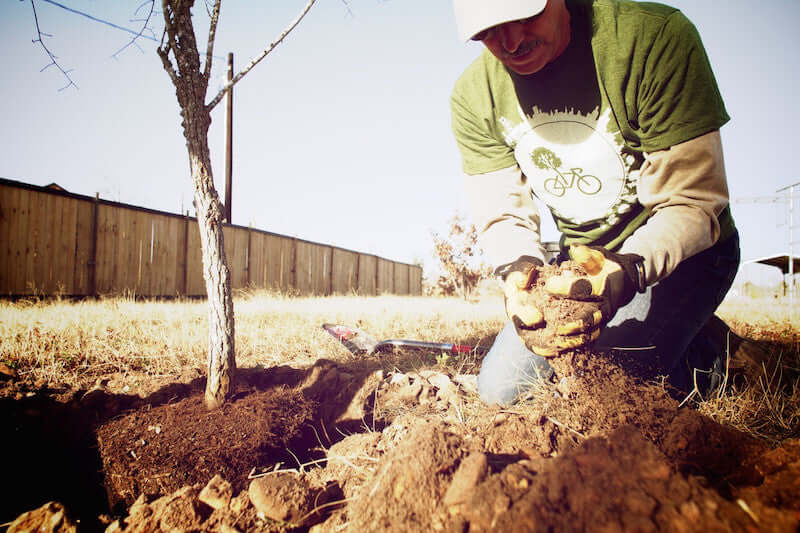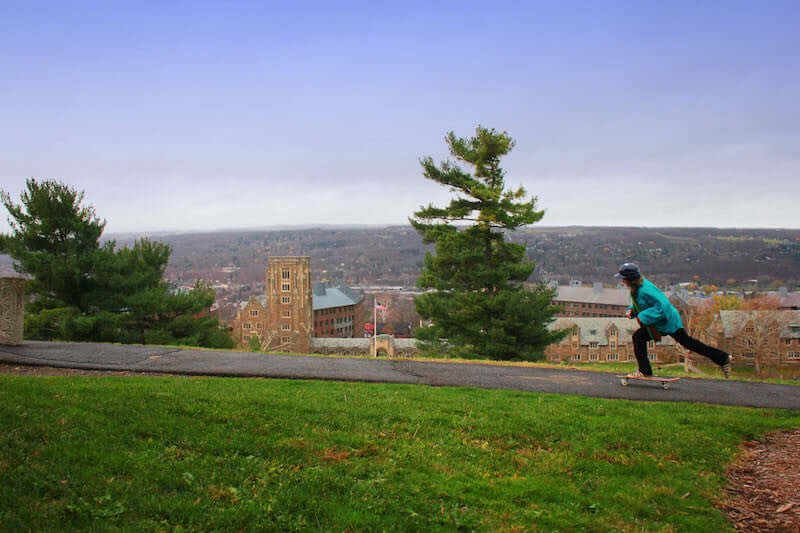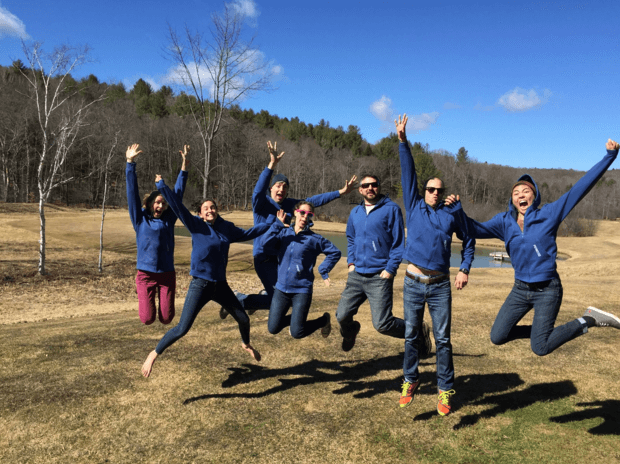Toward the end of 2011, inspired by a trip around the world and idea of a close friend, RETREET founder Grady McGahan started organizing a relief event in the community of Bastrop, TX. The area recently had been ravaged by a wildfire that scorched over 34,000 acres, including large parts of Bastrop State Park and The Lost Pines Forest, a unique stand of loblolly pines dating back to the Pleistocene era. The fire also burned 1,645 homes. McGahan and his friend’s plan was simple: mobilize a crew to plant trees for those rebuilding their community in order to help replace the forest that defined Bastrop. After careful planning and outreach, he started hearing from local Bastrop tree experts and other community leaders. They were ecstatic. McGahan posted the event info to Facebook. Before he knew it, there were 55 volunteers signed up from all over the United States.
In January of 2012, a caravan of bikes, trucks and cars led by McGahan traveled door to door through Bastrop, delivering and planting a variety of trees. The community’s response to the event was overwhelming. (“It blew people’s minds,” McGahan says.) And it was fun. After planting, the group rode bicycles through the countryside, explored the town’s history, and sampled local cuisine. So they decided to keep it going, and that’s how RETREET was born. 4 years later, the organization has planted over 4,000 trees in five states, as well as Ontario. They’ve been featured in a variety of media outlets, including The Weather Channel, FOX, CBS, and NBC, and they’ve garnered support from The Home Depot Foundation, LUSH Cosmetics, and The Arbor Day Foundation, among others, as well as from Bastrop resident Richard Linklater, the Oscar-nominated director known for films like Slacker, Dazed and Confused, and Boyhood. And they’ve found support from companies like Home Depot, as well as another Bastrop resident, Richard Linklater, the director best known for films such as Slacker, Dazed and Confused and 2015’s Oscar-winning tale, Boyhood. He and his family hosted the volunteer party after the latest planting event there.
It’s not hard to see why people want to get involved. McGahan is brimming with passion, and his attention to detail is the sort that allows these complicated planting operations to go off without a hitch. Not to mention every event involves great bike rides, delicious food and beverages, and the chance to meet a variety of interesting people. We had a long conversation with McGahan about RETREET a few weeks ago, the highlights of which we’ve included here. Read on the learn more about how the organization is replanting communities one tree at a time.
On the planting process…
McGahan: When you have a lot of people, things move quickly, especially when they’re motivated and know what they’re doing. RETREET lays everything out ahead of time – which trees we are going to plant and where they are going to go – so no executive decisions are being made with volunteers on site. The planting group converges at a central location, a park or large piece of private property, where a local urban forester, usually a member of the state’s forest service, gives a demonstration tree planting. Then, the group will plant up to a dozen trees to make sure everyone is on the same page and understands the process. Once complete, small groups are formed, tools are distributed, and a list of home sites is provided. Each team creates a fun and unique name (my favorite thus far is Crocodile Pancakes) and heads out to meet with residents.
The locals know when to expect the volunteers, called RETREETers, and are onsite when they arrive. As mentioned, the planting locations for the trees are already marked, utilities have been located, and planting supplies have been delivered. RETREETers have everything they need to transform a moonscape back into a landscape. They immediately start digging holes and sharing stories.
Deciding where to plant…
We aim to become an internationally known resource for standardized natural disaster response, like The Red Cross or Habitat for Humanity. To do that, we have to redefine the concept of disaster relief to include environmental recovery. The goal is to have RETREETs happening everywhere all the time, whenever and wherever disaster strikes.
For now, there are a few factors that influence where we hold a RETREET. First, proximity. If a major disaster strikes anywhere in Texas, certainly we are going to be involved. The recent tornadoes in Rowlett and Garland, for example, necessitate a RETREET response. We have a lot of very well formed partnerships in Texas that immediately activate when a catastrophe occurs close to home. Second, connection. There are certain places in the US that RETREET already has a following, wants to go, or has existing professional contacts. The wildfires and floods in Colorado caught our attention because we knew those were areas current RETREETers would want to go and new RETREETers would be easy to find. We also have friends at Colorado State University Forest Service who were interested in helping. Third, request. If someone from a disaster-struck community calls RETREET and asks for help, we’re going to do everything we can to initiate a project. Sometimes, that request even comes from a RETREETer. That’s how we ended up in Goderich, Ontario. After a tornado ripped that town apart, a local RETREETer, who had joined us in Bastrop and Lancaster, TX, asked us to bring the cavalry up to help replant his community. We did.
We are the only national resource for disaster-relief planting of this type, and potential project areas are in overwhelming supply. With our current capacity, we concentrate on locations where we know our efforts will be successful because our volunteers are engaged, community partners exist, and we have the ability to support the project. RETREET is rapidly growing into an international movement.
Seeing the World on A Bike…
RETREET curates a series of events over the course of a weekend that is meant to plug RETREETers directly into the local community. We host dinners, visit breweries, tour historic locations, put on concerts, and ride bicycles, all so we can come to a complete understanding of the place and its people. The cycling, in particular, allows us to become familiar with the geography and topography of an area, and often highlights the scope of the disaster in a way that is striking in scale. Locals are always invited to join us in all of these activities and they often do.
While cycling is certainly not a barrier to participating on RETREET, we always end up with more cyclists at the end of each event than we had at the beginning. That’s because our group of people is great, cycling is fun, and RETREET offers a safe place to have a group cycling experience for the first time. RETREETers have come home from RETREET, sold their car and bought a bicycle. Believe me, it’s happened.
Also, we generate a lot of goodwill towards cyclists by riding and planting. Our hope is that these positive feeling translate to cycling experiences that occur months and years after we’ve left. Perhaps a person who received trees from our organization will treat cyclists they encounter on the street while driving differently, with more respect. It’s all about sharing the road.
Staying Local…
We plant native or native-adapted, non-invasive species. We do our best to source trees that are propagated from local seed and raised nearby. It’s best to plant trees that are used to the conditions in which they’re going to spend the rest of their lives.
An approved species list is requested from the state’s forest service, whether that’s Texas A&M Forest Service, Oklahoma Forestry Services, Colorado State University Forestry Service, or their counterparts in any of the states in which we work. Once provided, we go through our partner Local Plant Source, who is able to search an innovative database by species, size, number, and radius to the planting site. Being able to ask for 15-gallon Shumard oaks raised within 100 miles of Oklahoma City and have a few options come back is amazing. Over time, we formulate partnerships with these local nurseries, and since we often return year after year to plant in the same areas, these relationships become really solid over time. With this model, we are sure we’re planting the right trees in the right places the right way.
So we say “Hey, listen, we’re planning on planting trees in this area, what’s the approved species list?” They give us that list and we start looking to source those from local nurseries.
The Importance of Planting Trees…
In the wake of a natural disaster, there are a whole host of systems that spring into action to replace the housing, infrastructure, and things that people lost, but very few resources exist to help repair the landscape. Environmental identity is incredibly important to a community. In fact, it’s the only thing everyone in a community has in common. Once the shared sense of place has been destroyed, that community becomes fractured. Replanting is desperately needed.
Planting trees during the recovery process is an incredible form of psychological relief. All sorts of research exits showing that nature, specifically trees, reduce trees and provide a whole host of health benefits to local residents. This, of course, is on top of all of the economic, social, and environmental benefits trees provide. Ironically, though they are so incredibly important, of everything that is lost the trees are what is going to take the longest to replace. You cannot rebuild an 80-year-old tree. All you can do is replant one and wait for 70-75 years for it to grow. The sooner we get that process started, the better.
Planting trees is a perfect volunteer opportunity for those who want to psychically help with a disaster relief effort. Unlike saturated opportunities during the first response, trees have permanent and increasing value. It’s not a bottle of water, blanket, or meal, something that will be consumed or discarded. A tree stays with a person and reminds them every day of the contribution made. Also, as a volunteer, you can do the entire process of planting a tree. It’s not one piece of a larger whole or an assembly line. You dig the hole, you plant, mulch, and water the tree, and you can come back in 30 years and see how much it’s grown. I guarantee the resident will remember you.
Planting trees in the wake of disaster is not a political or even environmental cause. It’s just people helping people by replacing devastation with hope. I’ve never met someone opposed to our mission, and in a world of divided ideas, that refreshing. Everyone has a place on RETREET.












